Categories: Featured Articles » Interesting electrical news
Number of views: 9900
Comments on the article: 0
Examples of the use of robots in the energy sector
This article is about using robots in the energy field. We will consider several modern solutions that not only make it easier for people to work and free up their time, but also serve as cost-saving services for the maintenance of industrial energy facilities.
Today, we can already confidently say that such tasks as: diagnostics of power lines, their cleaning from ice, inspection of wind turbines, maintenance of solar panels, diagnostics and maintenance of nuclear reactors - in the near future it will be possible to solve exactly mobile fully autonomous robots , or robots with remote control.
The use of robots is especially appropriate where human life may be at risk. For example, for the diagnosis of failed nuclear reactors or for the prevention of high-voltage power lines located at a height of tens of meters above the ground, it is robots that are correctly designed and properly configured are best suited.
Robots for the diagnosis and maintenance of high voltage power lines
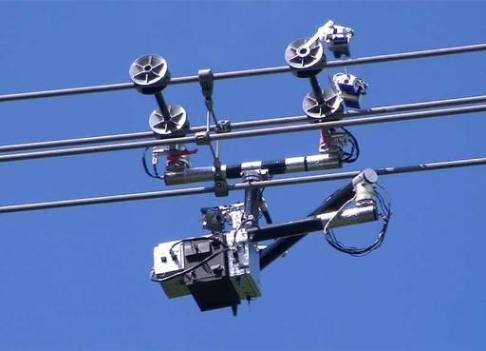
The Japanese company HiBot, at the request of the energy company Kansai Electric Power Company (KEPCO), developed, and in 2011 launched, the Expliner robot, designed for the diagnosis and maintenance of high-voltage power lines. The robot is simply suspended from the wires of the line, and the operator is left to remotely carry out visual control from the computer screen.
The movement of the robot along the line is similar to the movement of a train on rails, with the only difference being that the robot moves from below, under the wires. Moving slowly along the line, the Expliner uses laser sensors to detect corrosion on wires. Through the GPS channel, the robot receives data about its location and transmits it to the operator, and eight high-resolution cameras located on board the robot allow the operator to fully consider mechanical damage, whether it is a melted wire or a crack on it.
So, after the robot passes along the entire line, the repairmen will already know exactly where and what kind of malfunction takes place, what needs to be fixed, what and how to repair it.
Diagnostics of four simultaneously parallel wires is available. Obstacles such as clamps and gaskets the robot overcomes on its own, bypassing them, maneuvering, thanks to the moving center of gravity. The robot simply carries the wheels through the obstacle and moves on. If the obstacle is more complex, then the robot is transferred manually.
The use of the robot enables services to timely detect damage to lines, such as rust, internal corrosion (changed wire diameter), or mechanical damage. This greatly saves time and costs of inspecting lines in the traditional way, when a team of equipped workers must bypass the entire power line on their own.
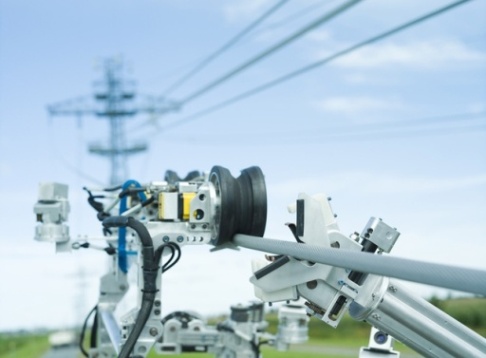
Canadians took a step further. Back in 1998, developers from the Hydro-Québec Institute thought about creating a more sophisticated robot for the diagnosis and maintenance of high-voltage power lines. And now, after 11 years, the LineScout robot was successfully presented at the presentation, and even won a prize from the Edison Institute of Electrical Engineering in 2009.
The idea came to developers not from scratch. Such a powerful snow storm passed in the northern states in the late 90s that the wires of one of the significant power lines were simply broken off under the load of ice frozen on them.
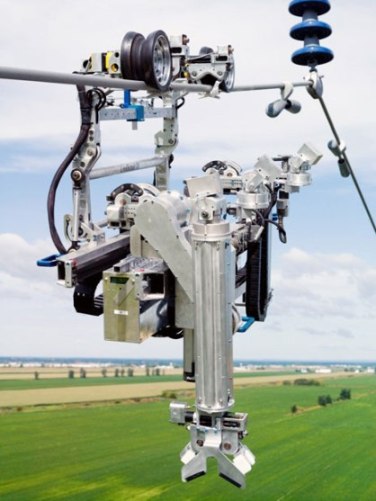
The result of ten years of work by engineers was a robot that is capable of not only rolling along wires, but also knowing how to manipulate various equipment.The robot, of course, is equipped with cameras and GPS, but plus it can clean the snow from the wires, unwind and tighten the bolts and nuts, remove foreign objects from the wires. Thanks to the presence of thermal imagers, the robot is able to evaluate the temperature of the wires.

The operator simply controls the robot from the computer using a special joystick. The LineScout robot proved to be quite effective during repeated tests in 2010 on lines with a current of up to 2 kA, under a voltage of 735 kV.
Solar Panel Cleaning Robot
For the construction of solar power plants, deserts flooded with sunlight are best suited. But how to solve the sand problem, because solar panelssand-covered after sandstorms are 60% less effective. If the panels were washed with water manually, this would require enormous labor costs, and quite frequent, moreover, the air temperature in the desert reaches 50 ° C. Robotic technology comes to the rescue again.
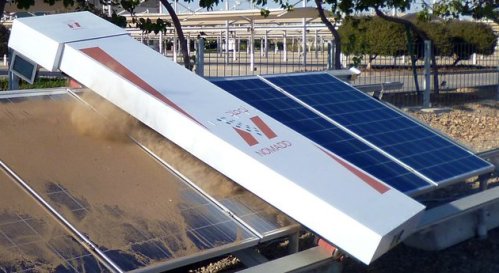
To solve the problem, a NOMADD (NO-water Mechanical Automated Dusting Device - “Automated Automated Dust Removal Device Without Using Water”) robot was created in Saudi Arabia. It is enough to install several such robots, one on each row of solar panels, and once a day they will clean the photosensitive coating without any water, simply with the help of special brushes.
So the solar panels will always remain clean, and the energy efficiency of solar power plants will increase. Imagine, the NOMADD robot alone can clear from 182 to 274 meters of panels - this is a huge amount of work, unbearable by the standards of manual maintenance. Robots work in parallel on each row of panels, and quickly and quickly carry out regular cleaning. The payback time for the robot system is three years, and the robots themselves do not require frequent maintenance.
The developers note: “This system is designed, developed and tested in Saudi Arabia in the most severe desert conditions. For such conditions, it is impossible to be properly prepared without having to experience them throughout the entire development process. That is our advantage. ”
Windmill Inspection Robot
Wind energy as an environmentally friendly source of electricity is today one of the fastest growing areas of alternative energy. Inventors are developing new projects for wind generators, but one thing remains unchanged - industrial wind generators are very large in size and, as a rule, always very tall structures.
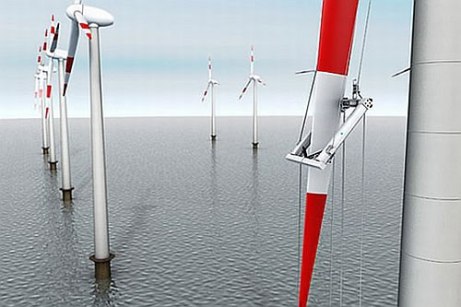
As the number of installed wind turbines around the world is growing, it is not at all surprising that some of them have already managed to find defects during their operation. Again robots are called upon to solve the problem of timely diagnosis of turbine blades, which can fearlessly climb sharp blades rotating at high altitudes. One of these robots is the RIWEA robot developed by the German Fraunhofer Institute, capable of working even on a rotating turbine.
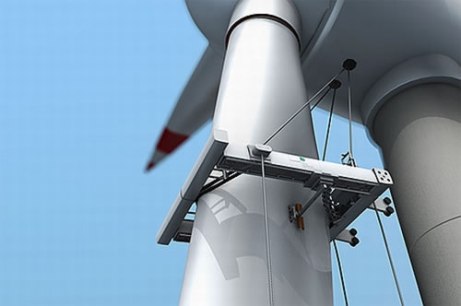
The robot moves along the rope, climbing higher and higher, whether it is a land or coastal turbine. Check for defects by means of an infrared emitter and a high resolution thermal imager. The operator simply receives the image and analyzes it. For the diagnosis of durable metal elements, the RIWEA robot is equipped with an integrated ultrasonic emitter and detector with high accuracy potential.
Today, in particular in the USA, about 60% of wind turbines in operation require repair. Thanks to such solutions as the RIWEA robot, it becomes possible to diagnose without premature decommissioning of the turbine, since the robot can easily climb even on rotating blades.
Operational diagnostics will identify turbines in need of urgent overhaul, and they can be turned off for repairs.And those turbines that are in acceptable condition will remain working, and the consumer will not experience any inconvenience.
Robots for work at nuclear facilities
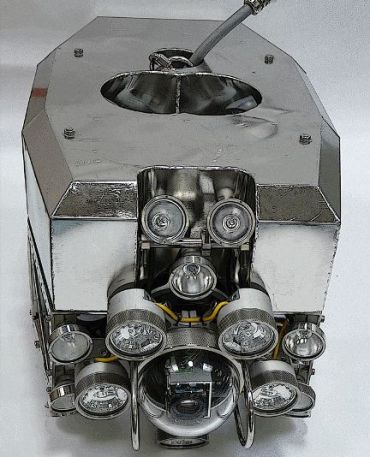
Since 1999, the topic of introducing robotics into nuclear facilities for their inspection and diagnostics has been actively discussed. For example, AREVA, a nuclear power plant service company, was the first to use an advanced solution for testing primary reactor loops. The SUSI robot helped to inspect and ultrasound the important components of one of the American reactors. The reactor turned out to be fully operational, and a decision was made to extend its life. Later, SUSI robots appeared in Europe.
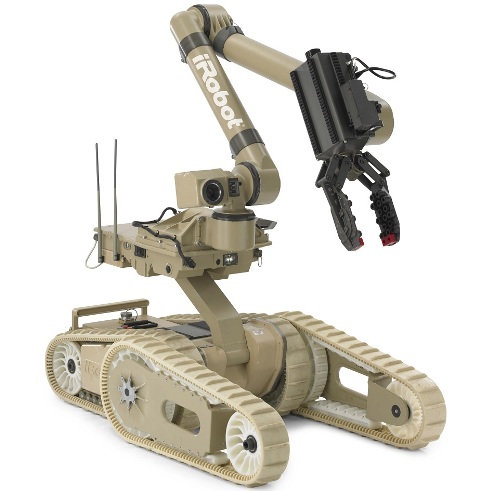
The iRobot company, in turn, provided four PackBot robots with which radiation samples were taken to eliminate the consequences of the accident at the Japanese Fukushima-1 nuclear power plant. Later, a more powerful robot Warrior 710 joined this work.
See also at bgv.electricianexp.com
:
